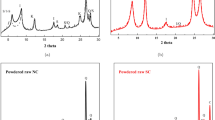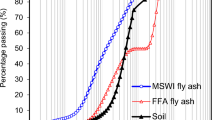Abstract
The single use of CaO has been regarded as relatively unsuccessful in fly ash activation when no other additives are used together, as it produces a considerably lower strength compared to other types of activators (e.g., alkaline activators). This study investigated two potential additives of nitrate compounds (i.e., Ca(NO3)2 and NaNO3) to improve the strength of a CaO-activated fly ash system. The results showed that the use of Ca(NO3)2 was greatly beneficial in the strength improvement of the binder system primarily due to the significant increase in (1) the dissolution degree of fly ash, (2) C–S–H formation, and (3) pore size refinement from early days; however, NaNO3 was much less advantageous in strength improvement, although it also aided in dissolving fly ash.







Similar content being viewed by others
References
Snellings R (2016) Assessing, understanding and unlocking supplementary cementitious materials. RILEM Tech Lett 1:50–55. https://doi.org/10.21809/rilemtechlett.2016.12
Bukhari SS, Behin J, Kazemian H, Rohani S (2015) Conversion of coal fly ash to zeolite utilizing microwave and ultrasound energies: a review. Fuel 140:250–266. https://doi.org/10.1016/j.fuel.2014.09.077
Provis JL (2014) Geopolymers and other alkali activated materials: why, how, and what? Mater Struct 47(1):11–25. https://doi.org/10.1617/s11527-013-0211-5
Bakharev T (2005) Geopolymeric materials prepared using Class F fly ash and elevated temperature curing. Cem Concr Res 35(6):1224–1232. https://doi.org/10.1016/j.cemconres.2004.06.031
Palomo A, Grutzeck MW, Blanco MT (1999) Alkali-activated fly ashes. Cem Concr Res 29(8):1323–1329. https://doi.org/10.1016/S0008-8846(98)00243-9
Shi C, Day RL (2000) Pozzolanic reaction in the presence of chemical activators: Part I. Reaction kinetics. Cem Concr Res 30(1):51–58. https://doi.org/10.1016/S0008-8846(99)00205-7
Shi C, Day RL (2000) Pozzolanic reaction in the presence of chemical activators: Part II. Reaction products and mechanism. Cem Concr Res 30(4):607–613. https://doi.org/10.1016/S0008-8846(00)00214-3
Jeon D, Jun Y, Jeong Y, Oh JE (2015) Microstructural and strength improvements through the use of Na2CO3 in a cementless Ca(OH)2-activated Class F fly ash system. Cem Concr Res 67:215–225. https://doi.org/10.1016/j.cemconres.2014.10.001
Li D, Chen Y, Shen J, Su J, Wu X (2000) The influence of alkalinity on activation and microstructure of fly ash. Cem Concr Res 30(6):881–886. https://doi.org/10.1016/S0008-8846(00)00252-0
Giergiczny Z (2004) Effect of some additives on the reactions in fly ash-Ca(OH)2 system. J Therm Anal Calorim 76(3):747–754. https://doi.org/10.1023/B:JTAN.0000032259.80031.b2
Fan Y, Yin S, Wen Z, Zhong J (1999) Activation of fly ash and its effects on cement properties. Cem Concr Res 29(4):467–472. https://doi.org/10.1016/S0008-8846(98)00178-1
Shi C, Day RL (1995) Acceleration of the reactivity of fly ash by chemical activation. Cem Concr Res 25(1):15–21. https://doi.org/10.1016/0008-8846(94)00107-A
Pradhan B (2014) Corrosion behavior of steel reinforcement in concrete exposed to composite chloride–sulfate environment. Constr Build Mater 72:398–410. https://doi.org/10.1016/j.conbuildmat.2014.09.026
Aggoun S, Cheikh-Zouaoui M, Chikh N, Duval R (2008) Effect of some admixtures on the setting time and strength evolution of cement pastes at early ages. Constr Build Mater 22(2):106–110. https://doi.org/10.1016/j.conbuildmat.2006.05.043
Chikh N, Cheikh-Zouaoui M, Aggoun S, Duval R (2008) Effects of calcium nitrate and triisopropanolamine on the setting and strength evolution of Portland cement pastes. Mater Struct 41(1):31–36. https://doi.org/10.1617/s11527-006-9215-8
Berke NS, Hicks MC (2004) Predicting long-term durability of steel reinforced concrete with calcium nitrite corrosion inhibitor. Cem Concr Compos 26(3):191–198. https://doi.org/10.1016/S0958-9465(03)00038-6
Ann KY, Jung HS, Kim HS, Kim SS, Moon HY (2006) Effect of calcium nitrite-based corrosion inhibitor in preventing corrosion of embedded steel in concrete. Cem Concr Res 36(3):530–535. https://doi.org/10.1016/j.cemconres.2005.09.003
Çullu M, Arslan M (2014) The effects of chemical attacks on physical and mechanical properties of concrete produced under cold weather conditions. Constr Build Mater 57:53–60. https://doi.org/10.1016/j.conbuildmat.2014.01.072
Karagol F, Demirboga R, Khushefati WH (2015) Behavior of fresh and hardened concretes with antifreeze admixtures in deep-freeze low temperatures and exterior winter conditions. Constr Build Mater 76:388–395. https://doi.org/10.1016/j.conbuildmat.2014.12.011
Asaga K, Tsuchiya Y, Shimada N, Torii H (2006) Reaction between NO3 − ion and 3CaO·Al2O3 in Aqueous Solutions with or without SO4 2− and Cl− ions. AIP Conf Proc 833(1):190–195. https://doi.org/10.1063/1.2207103
Balonis M, Mędala M, Glasser FP (2011) Influence of calcium nitrate and nitrite on the constitution of AFm and AFt cement hydrates. Adv Cem Res 23(3):129–143. https://doi.org/10.1680/adcr.10.00002
Dumm JQ, Brown PW (1996) Phase assemblages in the system Ca(OH)2—Al2O3—Ca(NO3)2—H2O. Adv Cem Res 8(32):143–153. https://doi.org/10.1680/adcr.1996.8.32.143
Renaudin G, Rapin JP, Humbert B, François M (2000) Thermal behaviour of the nitrated AFm phase Ca4Al2(OH)12(NO3)2•4H2O and structure determination of the intermediate hydrate Ca4Al2(OH)12(NO3)2•2H2O. Cem Concr Res 30(2):307–314. https://doi.org/10.1016/S0008-8846(99)00251-3
Taylor HF (1997) Cement chemistry. Thomas Telford, London
Hill R, Daugherty K (1996) The interaction of calcium nitrate and a Class C fly ash during hydration. Cem Concr Res 26(7):1131–1143. https://doi.org/10.1016/0008-8846(96)00074-9
ASTM (2015) Standard specification for coal fly ash and raw or calcined natural pozzolan for use in concrete. American Society for Testing and Materials, West Conshohocken
Suh J-I, Jeon D, Yoon S, Oh JE, Park H-G (2017) Development of strong lightweight cementitious matrix for lightweight concrete simply by increasing a water-to-binder ratio in Ca(OH)2–Na2CO3-activated fly ash system. Constr Build Mater 152(Supplement C):444–455. https://doi.org/10.1016/j.conbuildmat.2017.07.011
Oh JE, Jun Y, Jeong Y (2014) Characterization of geopolymers from compositionally and physically different Class F fly ashes. Cem Concr Compos 50:16–26. https://doi.org/10.1016/j.cemconcomp.2013.10.019
PANalytical BV (2012) X’Pert HighScore Plus software. version 3.0e edn., Almelo, Netherlands
ICDD (2000) PDF-2 Database. PA, USA
Shi C (1993) Activation of natural pozzolans, fly ashes and blast furnace slag. The University of Calgary, Ottawa
ASTM (2015) Standard test method for flow of hydraulic cement mortar. American Society for Testing and Materials, West Conshohocken
ASTM (2014) Standard practice for mechanical mixing of hydraulic cement pastes and mortars of plastic consistency. American Society for Testing and Materials, West Conshohocken
Zhang J, Scherer GW (2011) Comparison of methods for arresting hydration of cement. Cem Concr Res 41(10):1024–1036. https://doi.org/10.1016/j.cemconres.2011.06.003
Song S, Jennings HM (1999) Pore solution chemistry of alkali-activated ground granulated blast-furnace slag. Cem Concr Res 29(2):159–170. https://doi.org/10.1016/S0008-8846(98)00212-9
Caruso F, Mantellato S, Palacios M, Flatt RJ (2017) ICP-OES method for the characterization of cement pore solutions and their modification by polycarboxylate-based superplasticizers. Cem Concr Res 91:52–60. https://doi.org/10.1016/j.cemconres.2016.10.007
Allmann R, Hinek R (2007) The introduction of structure types into the Inorganic Crystal Structure Database ICSD. Acta Crystallogr Sect A: Found Crystallogr 63(5):412–417. https://doi.org/10.1107/S0108767307038081
Feldman RF, Beaudoin JJ (1991) Pretreatment of hardened hydrated cement pastes for mercury intrusion measurements. Cem Concr Res 21(2):297–308. https://doi.org/10.1016/0008-8846(91)90011-6
Aligizaki KK (2006) Pore structure of cement-based materials: testing, interpretation and requrements. Taylor & Francis, London
O’Neil MJ (2013) The Merck index: an encyclopedia of chemicals, drugs, and biologicals. Merck and Co., Inc, RSC Publishing, Whitehouse Station, NJ
Rumble J (2017) CRC handbook of chemistry and physics, 98th edn. Taylor & Francis, Boca Raton
Biernacki JJ, Williams PJ, Paul ES (2001) Kinetics of reaction of calcium hydroxide and fly ash. ACI Mater J. https://doi.org/10.14359/10403
Shi C (1998) Pozzolanic reaction and microstructure of chemical activated lime-fly ash pastes. ACI Mater J 95(5):1. https://doi.org/10.14359/396
Mehta PK, Monteiro PJM (2006) Concrete: microstructure, properties, and materials. McGraw-Hill Publishing, New York
Bakolas A, Aggelakopoulou E, Moropoulou A, Anagnostopoulou S (2006) Evaluation of pozzolanic activity and physicomechanical characteristics in metakaolin-lime pastes. J Therm Anal Calorim 84(1):157–163. https://doi.org/10.1007/s10973-005-7262-y
Wang S-D, Scrivener KL (1995) Hydration products of alkali activated slag cement. Cem Concr Res 25(3):561–571. https://doi.org/10.1016/0008-8846(95)00045-E
Collier NC, Sharp JH, Milestone NB, Hill J, Godfrey IH (2008) The influence of water removal techniques on the composition and microstructure of hardened cement pastes. Cem Concr Res 38(6):737–744. https://doi.org/10.1016/j.cemconres.2008.02.012
Frías Rojas M (2006) Study of hydrated phases present in a MK–lime system cured at 60 C and 60 months of reaction. Cem Concr Res 36(5):827–831. https://doi.org/10.1016/j.cemconres.2006.01.001
Baquerizo Ibarra LG (2015) Impact of water activity on the mineralogy of hydrated cement. École polytechnique fédérale de Lausanne, Swiss
Lothenbach B, Le Saout G, Gallucci E, Scrivener K (2008) Influence of limestone on the hydration of Portland cements. Cem Concr Res 38(6):848–860. https://doi.org/10.1016/j.cemconres.2008.01.002
Schüth F, Sing KSW, Weitkamp J (2002) Handbook of porous solids. Wiley-Vch, Weinheim. https://doi.org/10.1002/9783527618286
Richardson I, Girão A, Taylor R, Jia S (2016) Hydration of water-and alkali-activated white Portland cement pastes and blends with low-calcium pulverized fuel ash. Cem Concr Res 83:1–18. https://doi.org/10.1016/j.cemconres.2016.01.008
Brus J, Abbrent S, Kobera L, Urbanova M, Cuba P (2016) Advances in 27Al MAS NMR Studies of Geopolymers. Annu Rep NMR Spectrosc 88:79–147. https://doi.org/10.1016/bs.arnmr.2015.11.001
Andersen MD, Jakobsen HJ, Skibsted J (2006) A new aluminium-hydrate species in hydrated Portland cements characterized by 27Al and 29Si MAS NMR spectroscopy. Cem Concr Res 36(1):3–17. https://doi.org/10.1016/j.cemconres.2005.04.010
Skibsted J, Henderson E, Jakobsen HJ (1993) Characterization of calcium aluminate phases in cements by aluminum-27MAS NMR spectroscopy. Inorg Chem 32(6):1013–1027. https://doi.org/10.1021/ic00058a043
Yum WS, Jeong Y, Yoon S, Jeon D, Jun Y, Oh JE (2017) Effects of CaCl2 on hydration and properties of lime(CaO)-activated slag/fly ash binder. Cem Concr Compos 84(Supplement C):111–123. https://doi.org/10.1016/j.cemconcomp.2017.09.001
Jeong Y, Park H, Jun Y, Jeong JH, Oh JE (2016) Influence of slag characteristics on strength development and reaction products in a CaO-activated slag system. Cem Concr Compos 72:155–167. https://doi.org/10.1016/j.cemconcomp.2016.06.005
Acknowledgements
This study was supported by research facilities from the Institute of Construction and Environmental Engineering at Seoul National University and the Institute of Engineering Research at Seoul National University. The authors gratefully acknowledge Se Jin Lee in the KBSI Jeonju Center for assistance with mercury intrusion porosimetry and Sin Ae Chae in the KBSI Western Seoul Center for assistance with the solid-state NMR experiments.
Funding
This study was supported by the Basic Science Research Programs (NRF-2016R1D1A1B03932908) through the National Research Foundation of Korea (NRF), funded by the Ministry of Education, Republic of Korea.
Author information
Authors and Affiliations
Corresponding authors
Ethics declarations
Conflict of interest
The authors declare that they have no conflict of interest.
Additional information
Publisher's Note
Springer Nature remains neutral with regard to jurisdictional claims in published maps and institutional affiliations.
Electronic supplementary material
Below is the link to the electronic supplementary material.
Rights and permissions
About this article
Cite this article
Suh, JI., Yum, W.S., Song, H. et al. Influence of calcium nitrate and sodium nitrate on strength development and properties in quicklime(CaO)-activated Class F fly ash system. Mater Struct 52, 115 (2019). https://doi.org/10.1617/s11527-019-1413-2
Received:
Accepted:
Published:
DOI: https://doi.org/10.1617/s11527-019-1413-2




